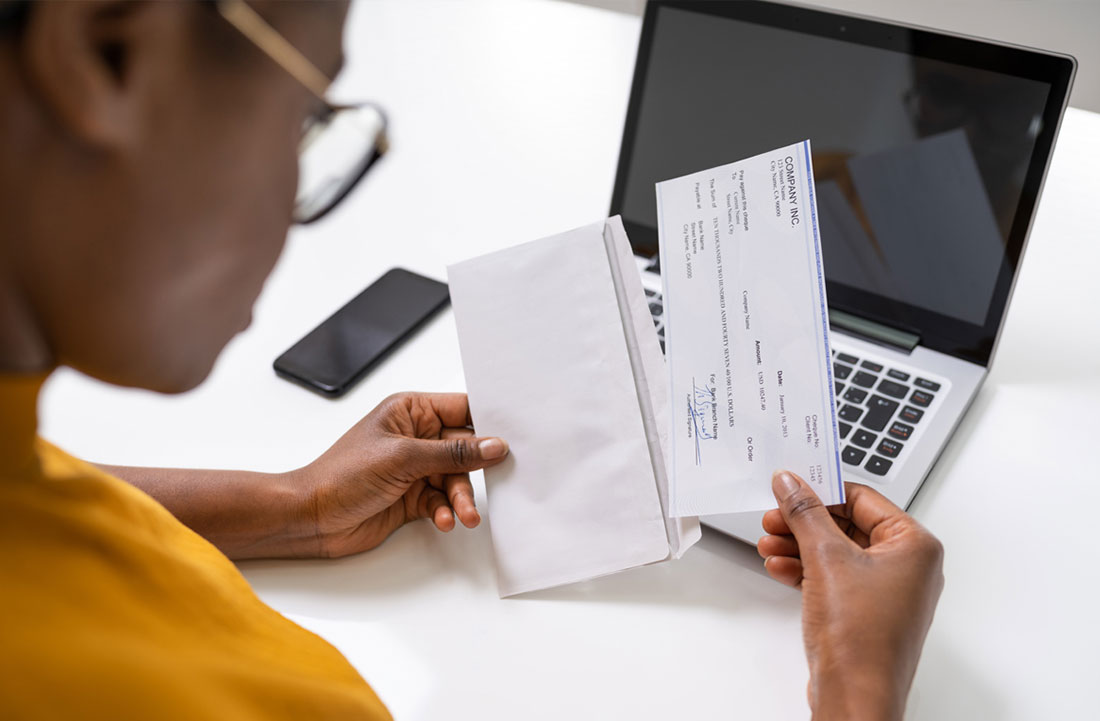How to Protect Yourself from Rising Check Fraud
March 18, 2024

With the widespread transition to digital payments, the use of paper checks seems to be on the decline. However, check writing remains a popular payment preference for many businesses and people. Since checks are still widely used, it’s crucial to understand their susceptibility to fraud and how to protect your finances.
What is Check Fraud?
Check fraud takes many forms, including stealing blank checks, altering stolen checks, or forging checks. Fraudsters then use the stolen or forged check to withdraw money, make purchases, or open new accounts in the victim’s name. These actions can result in significant financial loss and major legal ramifications.
Even though the personal use of checks is declining, check fraud has increased significantly over the last few years. The Financial Crimes Enforcement Network (FinCEN) reported that financial institutions filed more than 350,000 Suspicious Activity Reports (SARs) of check fraud in 2021. In 2022, that number almost doubled to over 680,000 check fraud-related SARs, and by the end of the third quarter of 2023, the number was nearly 450,000. This substantial increase highlights the need to remain vigilant and stay informed about potential check fraud schemes.
What is Check Washing?
One form of check fraud that has been on the rise again lately is known as “check washing.” This tactic involves thieves stealing checks from personal and business mailboxes, or even U.S. Postal Service boxes.
The fraudsters then soak the checks in ink-removing chemicals to erase the original information written on them, like the dollar amount, date, and payee name – leaving a blank check for the scammer to write in any information they want. They can make the check payable to themselves, another criminal, or an alias. They can also increase the payment amount up to thousands of dollars.
For example, a legitimate check for $50 written to a family member to celebrate an upcoming birthday can be washed and rewritten as a check for $5,000 to a fraudster.
Protecting Yourself Against Check Fraud
- Use checks with security features. Elements like microprinting and watermarks make it much more difficult for fraudsters to counterfeit or alter them.
- Write checks using a gel pen. Gel ink contains characteristics that are more difficult to remove than other types of ink. This will make your checks less likely to be altered through check washing.
- Write the amount to be paid in words. When writing a check, always write out the payment amount in words on the payment line. This will fill up most of the space, making it more challenging for criminals to alter the check.
- Use electronic payments instead of mailing checks. Online banking and bill payment services are safer because they are encrypted. Plus, online payments are much faster than mailing a paper check and are less likely to be intercepted.
- Don’t leave mail in your mailbox. Grab your mail out of your mailbox promptly after it’s delivered. Never leave mail in your mailbox overnight or for days at a time. When sending outgoing mail, put it in your mailbox as close as possible to when your mail carrier usually comes.
- Drop off outgoing mail before pickup. If you are depositing mail in the blue outgoing mail collection boxes at your local post office, drop your mail in as close to the last pickup time as possible. This way, you can reduce the time your mail sits unsupervised and susceptible to thieves.
For even more security, take your outgoing mail into the post office and give it directly to a postal service employee.
- Review your financial accounts regularly. Monitor your account transactions regularly and be sure to review your monthly account statements. Be on the lookout for any unauthorized transactions. Report suspicious activity immediately to the credit union.
- Use the USPS Hold Mail Service. If you’re going on vacation or will be away from home for several days, put your mail on hold. This service will temporarily pause your mail delivery until you return, up to 30 days. You can also ask a trusted neighbor, friend, or family member to collect your mail.
- Sign up for USPS’s free Informed Delivery Service. With Informed Delivery, the USPS will email you pictures of the mail that they will deliver to your home that day. That way, you know exactly what’s coming your way and if anything is missing.
How to Report Check Fraud
Report missing checks or other check fraud as soon as you become aware of it.
- Notify the credit union or other financial institution(s). Have the following details handy:
- Check number(s)
- Date(s) cashed
- Amount #(s)
- Payee(s)
- Report the crime to your local police department and/or State Attorney General’s Office.
- Report fraud involving a mailed check to the United States Postal Inspection Service (USPIS).
- Online: https://www.uspis.gov/report
- By mail:
Criminal Investigations Service Center
Attn: Mail Fraud
433 W. Harrison Street, Room 3255
Chicago, IL 60699-3255
- Contact the Federal Trade Commission (FTC).
- Online: https://reportfraud.ftc.gov
- By phone: 1-877-FTC-HELP or 1-877-ID-THEFT
- Visit the U.S. Department of Justice (DOJ) for a full list of government agencies where different types of fraud can be reported.
We’re Here to Help!
Unfortunately, fraud and scams continue to rise annually. However, the best way to protect yourself is to understand how these crimes work. By staying in the know, you’re more likely to spot and avoid a scam.
If you believe you were a victim of fraud, contact us immediately. Please stop by any of our convenient branch locations or call 888-777-9982 to speak with a team member.
Disclosures
-
This credit union is federally insured by the National Credit Union Administration.
Disclosures
-
Equal Housing Lender



